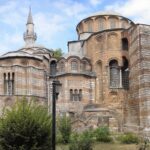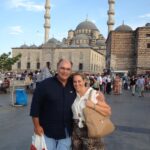New York times destaca as obras do grande arquiteto Mimar Sinan. O jornalista ANDREW FERREN veio para Istambul e faz três dias de passeio, dois em istambul, e um dia na cidade de Edirne, 230 quilômetros de distancia para Istambul seguindo as obras do arquiteto Mimar Sinan.
Confira o texto em original,publicado no dia 8 de junho em inglês. Para quem quiser a tradução para português, quem ajudar, podemos fazer uma tradução.
O texto original está presente neste seguinte link : http://travel.nytimes.com/2012/06/10/travel/tracking-turkeys-first-starchitect.html
Tracking Turkey’s First Starchitect
Published: June 8, 2012
“The only way to arrive at Semsi Pasha Mosque is by water,” my guide said as our little boat dodged two tankers on the Bosporus. On every shore around us, the domes and minarets of some of Istanbul’s nearly 3,000 mosques delineated the skyline of a city that looks like no Other.
Soon the captain made the first of several attempts to part the row of fishermen casting offshore. Minutes later, amid the cries of sea gulls, we disembarked in Uskudar on the Asia side and stood before the 16th-century Semsi Pasha, one of the city’s most diminutive mosques, a micro-version of massive temples like the famous Blue Mosque. With its simple stone walls and just a whisper of stained glass in the windows, its understated interior is an elegantly restrained evocation of paradise on earth.
I had come to Turkey on an architectural pilgrimage. After several recent visits to explore the country’s supercharged contemporary art and design scenes, I still yearned to know more about the work of a 16th-century architect and engineer named Sinan. He was hardly just any architect and engineer. Sinan (circa 1490-1588) was chief architect and civil engineer of the Ottoman Empire, working when the empire was at its apogee; his employers, Sultan Suleyman the Magnificent and his heirs, were the most powerful men on earth.

In a career that began when he was 40 and spanned five decades, Sinan built some 300 structures across Eastern Europe and the Middle East. Since most Western visitors to Turkey have never heard of Sinan, guides often compare him to his contemporary, Michelangelo. But given the scope, scale and sheer quantity of his buildings, that’s something of an insult to Sinan. Michelangelo made spectacular contributions to a few buildings in Rome and Florence. Sinan has hundreds of monumental structures still in daily use, from Belgrade to Mecca. You might say that Sinan was the world’s first “starchitect.”
The holy grail of my pilgrimage was in Edirne, a former capital of the Ottoman Empire near the Turkish border with Bulgaria and Greece, where Sinan’s Selimiye Mosque, with its four elegantly slender minarets, crowns the city’s center. Sinan considered Selimiye his masterpiece, and in 2011 Unesco agreed with him, declaring the entire mosque complex, known in Turkish as a kulliye and featuring schools, almshouses, hospitals, baths and a covered bazaar, a World Heritage Site.
Sinan was “the Euclid of his day,” said Dogan Kuban, author of more than 70 books on Islamic architecture. “At St. Peter’s in Rome, your eye is drawn to the dome itself,” he said in a recent conversation. “Sinan’s shallow domes, however, with their abstract painted decoration, seem to magically float overhead. Instead of the structure, you contemplate the space.”
To better understand what I’d be looking at in Edirne, I asked the bespoke travel agency Sea Song Tours in Istanbul to provide me with a three-day crash course in Sinan. By visiting more than a dozen of his buildings in Istanbul, I might better understand how his experimentation with complex geometric compositions transformed thick stone walls into columns, arches, domes and half-domes — and things called spandrels and squinches — as he made the vertical transition from the mosques’ square floors to their round ceilings.
My guide, the aptly named Sinan Yalcin, brilliantly zeroed in on the salient details of each building in 20- to 30-minute visits as we zigzagged through Istanbul, crossing back and forth from Europe to Asia by car and boat. Though we moved quickly, ate cheaply and fast in local lunch spots, and nearly froze standing shoeless in vast stone structures in mid-March, it was perhaps the most luxurious trip I’ve ever taken — 72 hours dedicated to one architectural marvel after another.
The first stop was Sehzade Mosque in Edirnekapi, built early in Sinan’s career. When it was finished in 1548, the architect recognized that he still had something to learn. On the mosque’s exterior lateral walls, Sinan cleverly organized the buttresses that support the weight of the dome into orderly colonnades. To create symmetry, he placed doors in the center of those colonnades. But inside the mosque, the doors meant worshipers now came and went from the middle of the room rather than from the back. “A sacred space meant for prayer and contemplation became a passageway,” Sinan the guide explained. “It was a mistake he would never repeat.”
Nearby is Sinan’s most important mosque in Istanbul. Commissioned by Suleyman for his own tomb and completed in 1558, the Suleymaniye Mosque sits atop the most prominent hill above the Golden Horn, and remains among the most visible monuments in the city. Sinan artfully modulated the height of the four minarets, enhancing the illusion that the mosque floats above the city. Recently reopened after a three-year restoration, the vast complex gleams. Still, its monumentality left me a little cold.
To get the blood flowing back into our frozen feet, we walked to our next stop, Rustem Pasha Mosque, nestled in the city’s bustling spice market, where merchants crowd the sidewalk, and rivers of mostly female shoppers flow through the streets. Sinan solved the problems of this less-than-tranquil site by raising the entire complex above street level. Two unassuming staircases lead to a serene plaza floating above the hubbub, but the real treasure awaits within, where brilliant 16th-century Iznik tile work provides worshipers with a garden of cobalt, turquoise and carnelian tulips and emerald green leaves.
The next day began early at Mihrimah Sultan II Mosque in Edirnekapi, which was commissioned by Suleyman’s daughter Mihrimah. Entering just after prayers on a gray March morning was like stepping into a box of light. Laced with clear and stained-glass windows, the walls of the mosque are a marvel of 16th-century masonry. Sinan was said to be in love with Mihrimah, but as she was married to Rustem Pasha, Suleyman’s grand vizier, he contented himself with making the mosque as luminous as possible to reflect her name, which means “sun and moon.” On the summer solstice, it is an ideal place to watch the sun set and the moon rise on opposite sides of the sky.
Sinan the guide was full of juicy tidbits about life in Sinan the architect’s day. For instance, despite the Ottomans’ highly patriarchal society, daughters like Mihrimah often enjoyed greater wealth and longer life than many of the sultans’ sons. On the day a new sultan was proclaimed, his brothers would be killed to avoid power struggles.


A mesquita de Selimiye, até o próprio arquiteto Mimar Sinan destaca esta sua obra, como a obra da época de mestre dele .
This latter point was made as we admired the Selim II tombs situated between Hagia Sofia and the Blue Mosque, where stylized turbans made of white cloth adorn the caskets containing the bodies of men of the sultan’s family. Next door, the newly restored Hurrem baths, commissioned by Suleyman’s beloved Slavic wife Roxelana, have just reopened.
After a fabulously no-fuss lunch of kofte (spiced ground meat patties) and red beans at a local lunch counter, we walked 10 minutes to Sokollu Pasha Mosque, also famous for its gorgeous Iznik tiles. The approach offers a dramatic and ever-expanding view of the sweeping roof that shelters the ablutions fountain in the foreground and the seemingly infinite repetition of domes and arches of the mosque itself. In the middle of the afternoon we were the only visitors.
From here we took the boat over to Semsi Pasha and then walked to the nearby Mihrimah Sultan I Mosque (1549) also in Uskudar. One element that Sinan tweaked here was the double porch — the broad overhang that covers the area where the faithful take their shoes off and where latecomers can kneel in prayer protected from the elements. Dramatically widened here to cover the ablutions fountain, the design innovation was employed in rural mosques all over the Middle East.
The final day began with a three-hour drive northwest from Istanbul to Edirne, where the dome and minarets of Sinan’s Selimiye Mosque first come into view miles outside of town. As one gets closer, the mosque appears as a tautly composed jumble of shapes — spheres, cones and cylinders — wrapped in honey-colored sandstone or clad in matte gray lead. However, once past the heavy green curtain that shelters the entrance of virtually all mosques, the artful complexity of the exterior’s seemingly impenetrable walls dissolves into a tracery of stone columns and arches embracing one vast, harmonious space.
Despite its astonishing scale — the dome of Selimiye surpasses by a few inches that of Istanbul’s Hagia Sofia — no detail was too small to escape Sinan’s attention, from the intricate carving of the minbar, or stepped pulpit, to the hidden relief of an upside-down tulip carved into a column, perhaps a reference to the landowner whose tulip farm was appropriated to build the mosque.
Beyond history and architecture, Edirne is known to Turks today as Liver Town — all restaurants serve the stuff, sliced into strips, breaded and fried, and little else. After consulting with several shop owners, Sinan the guide found a place he liked and we squeezed in amid the locals for a hearty lunch.
With our bellies as well as my camera’s memory card full, we strolled through the sprawling Rustem Pasha Caravanserai, part of which is now a hotel, en route to the car. About an hour outside of Istanbul we stopped to admire the Sultan Suleyman Bridge, built by Sinan in 1567 and still holding its own against time and the industrial skyline behind. Then as darkness fell, we slipped back into the city that five centuries later still belongs to Sinan.





